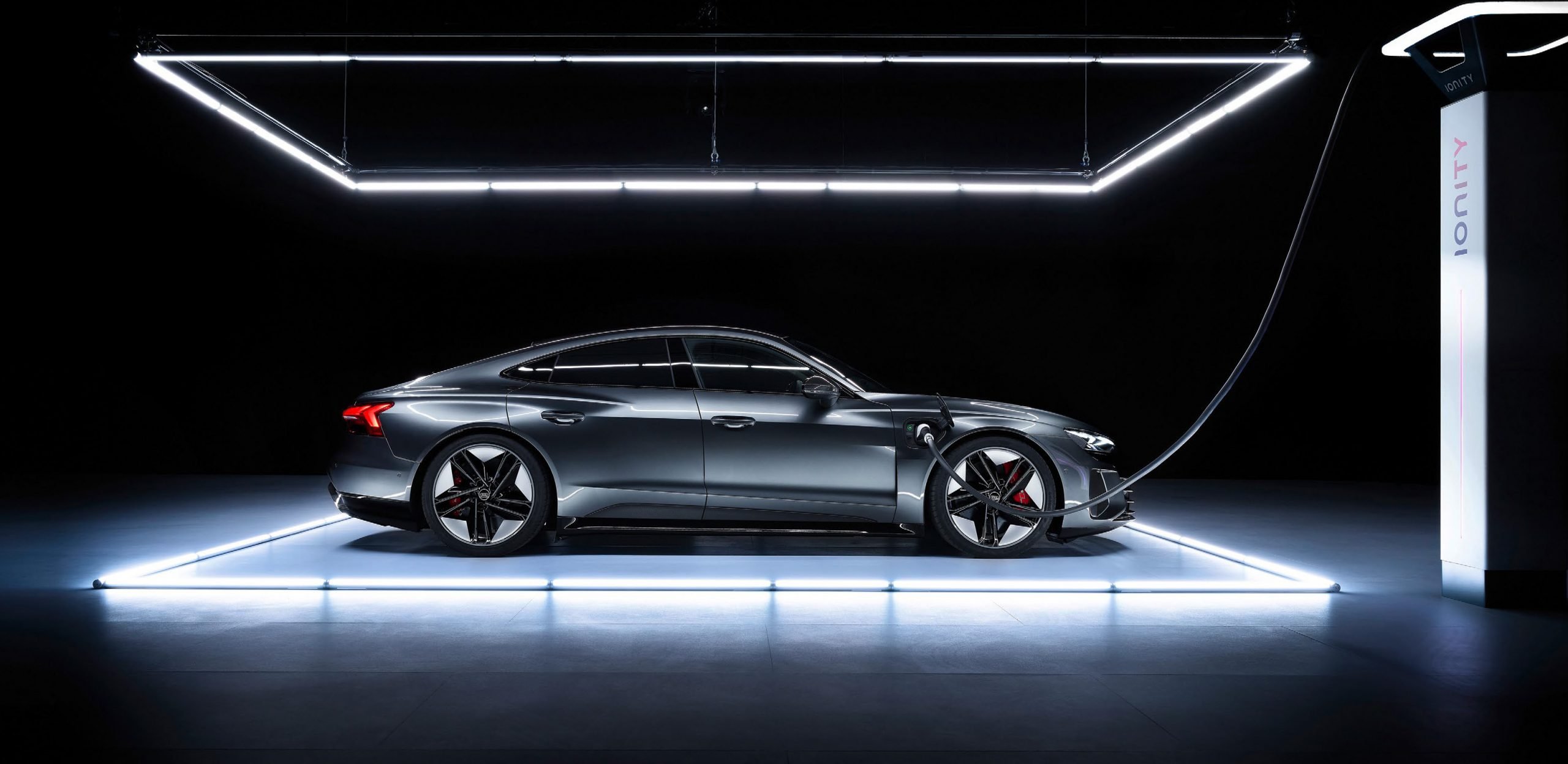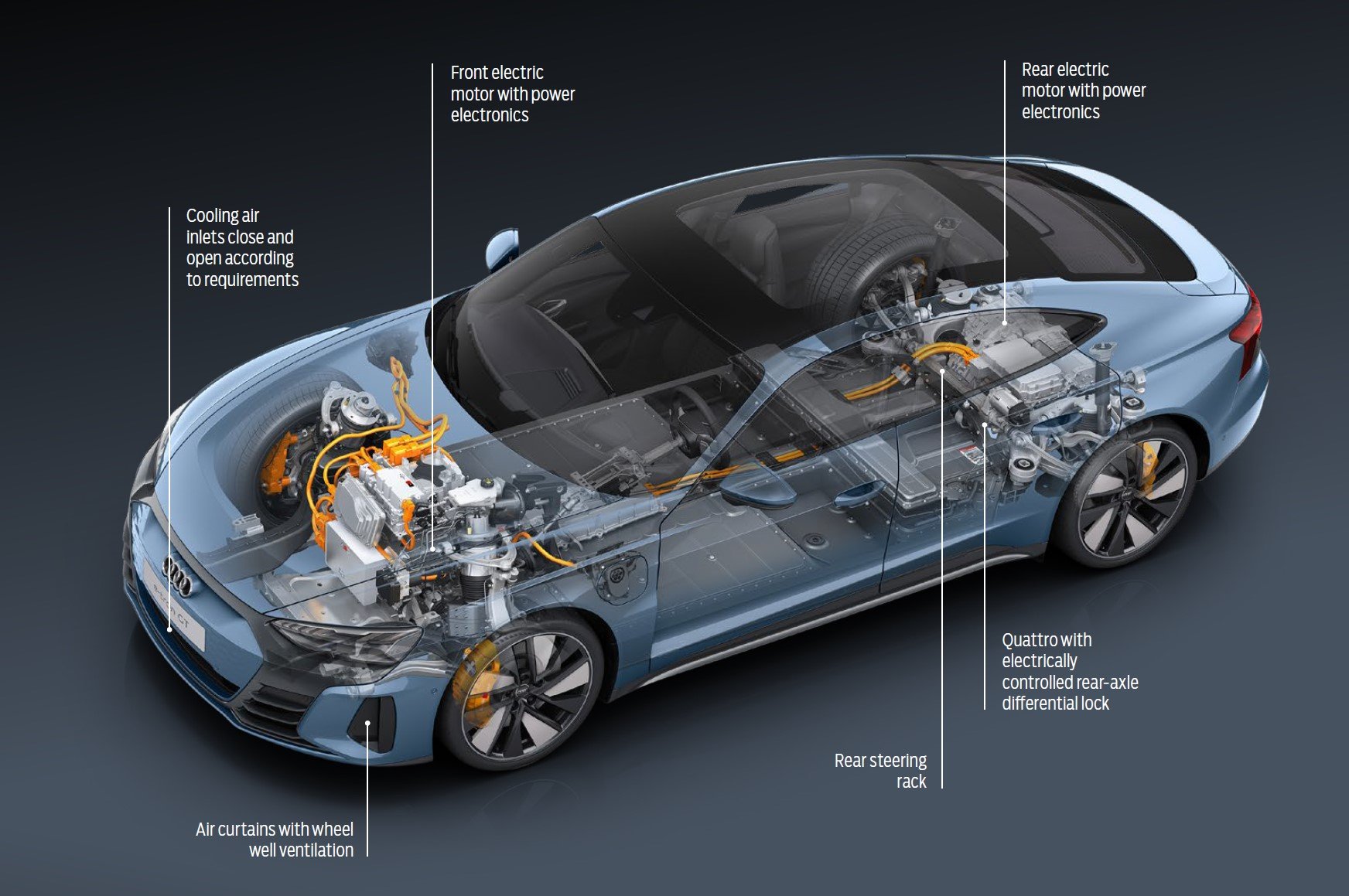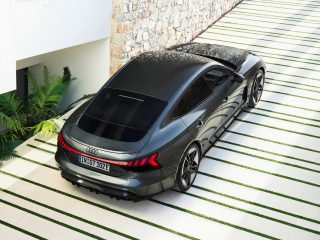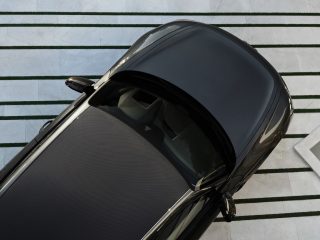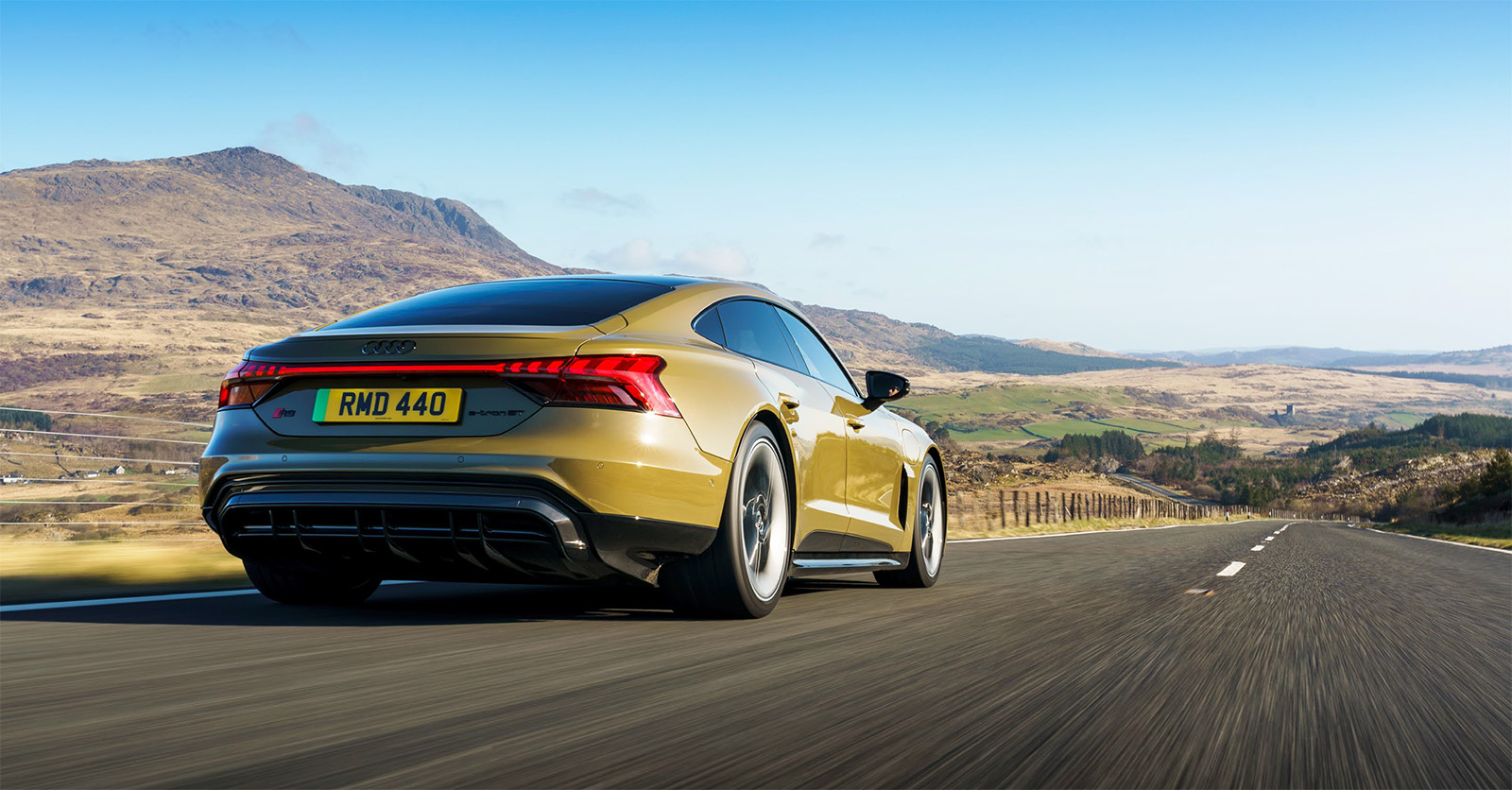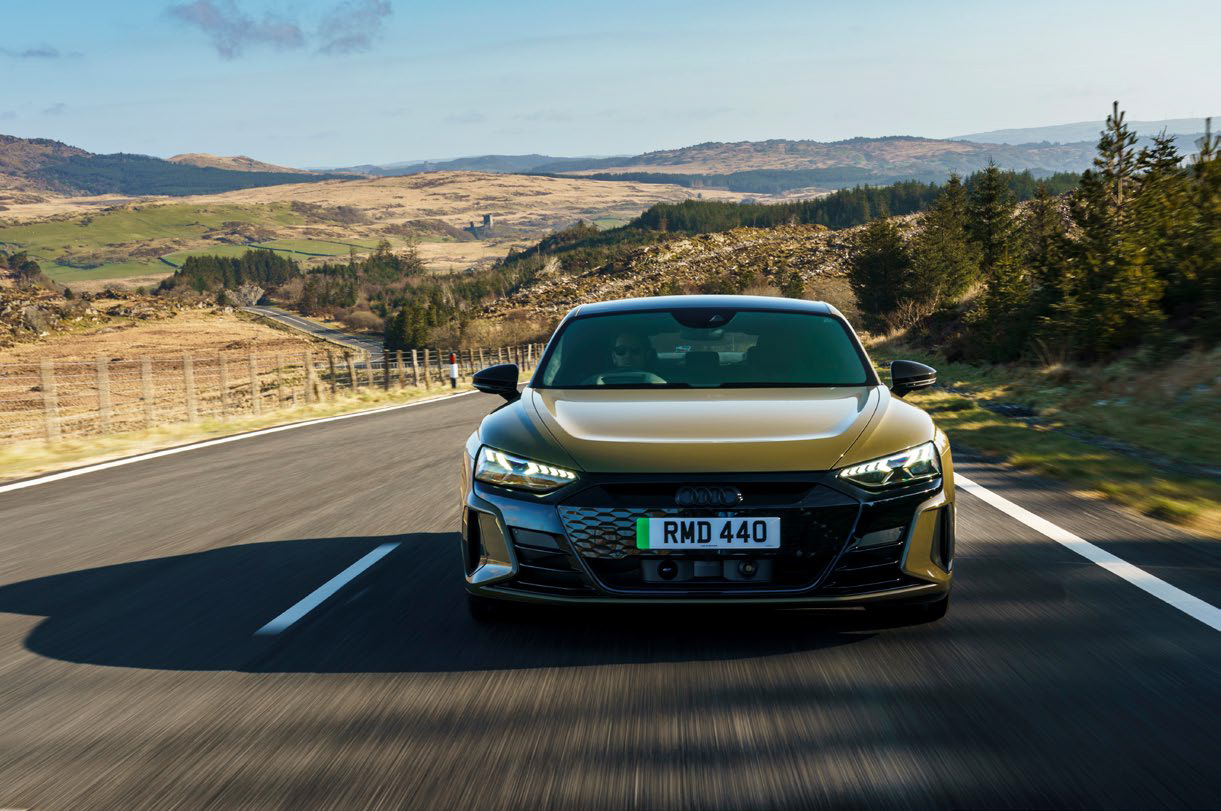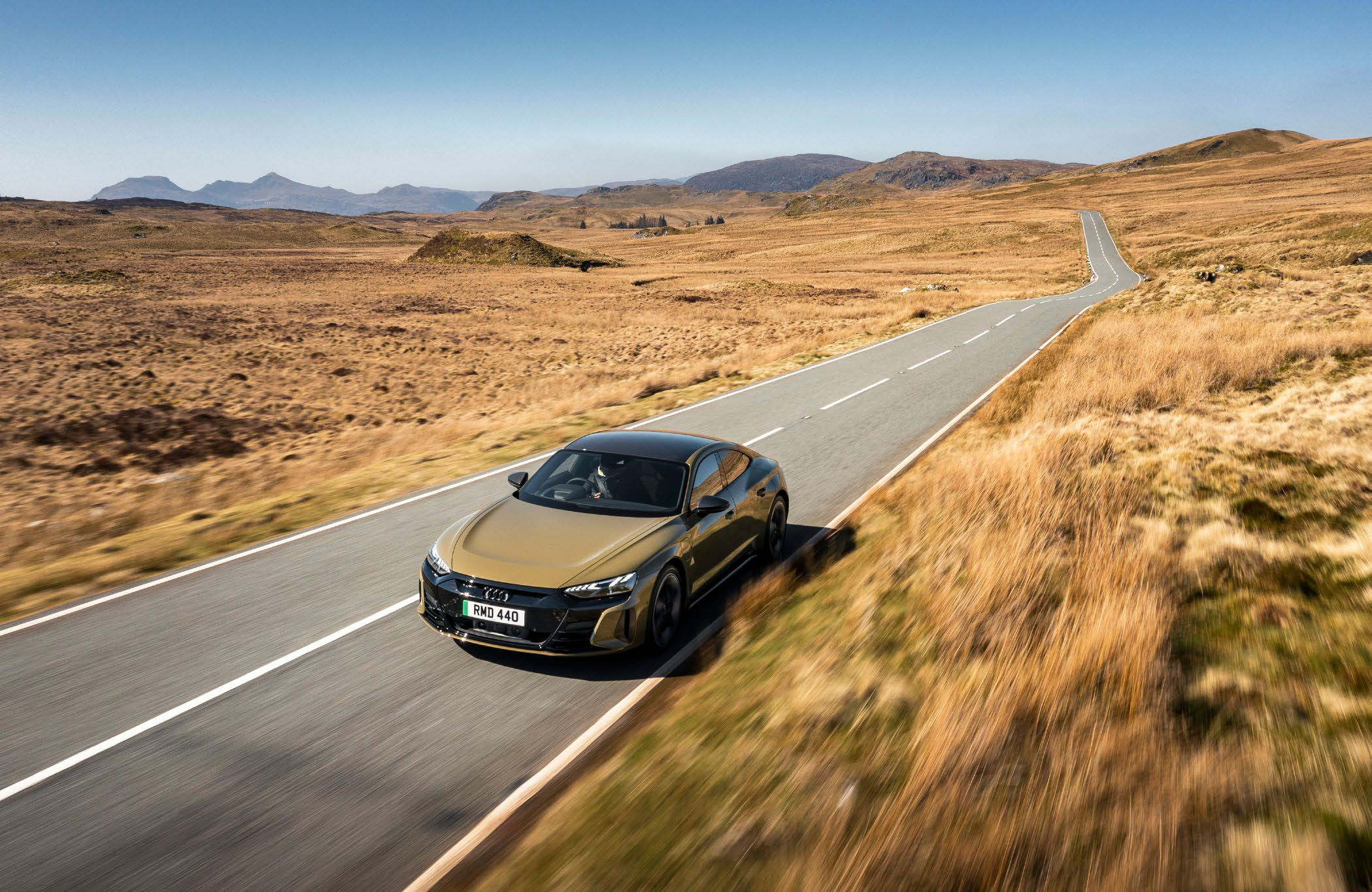Audi’s new e-tron GT and RS e-tron GT promise to continue the brand’s technological progressiveness that began with a slogan.
FIFTY YEARS AGO, AUDI’S VORSPRUNG durch Technik slogan was born from the 1969 merger of Auto Union (based in Ingolstadt) and Neckarsulmer NSU Motorenwerke, forming Audi NSU Auto Union, headquartered at Neckarsulm. The portfolio of this new company featured a diverse range of models, including the air-cooled, rear-engined NSU Prinz, rotary-engined NSU Ro80 and water-cooled, front-engined Audi 60 and 100 models. Hans Bauer from the Audi NSI advertising department thought up the slogan as a way to communicate the broad range of models and technologies offered by the company.
The slogan was first used in print and billboard advertising in January 1971 and soon after in Audi NSU brochures. It was often anglicised to less catchy versions, including; “Audi. A nice bit of technology” and “Audi. Relaxed driving with perfect technology.”
However, after the company defining Ur Quattro arrived in 1980, Vorsprung durch Technik became more widely used and by 1986 it was entrenched as part of Audi’s corporate identity.
Beyond the near-universal adoption of quattro technology, Vorsprung durch Technik has also overseen the arrival of many groundbreaking Audi models and technologies including the RS sub-brand, TT, R8 supercar, aluminium spaceframe construction, Le Mans dominance and the 2018 introduction of the Audi e-tron – the brand’s first fully electric vehicle.
“Audi will not rest on the technological advancement of the past years,” began Hildegard Wortmann, Member of the Board of Management of Audi for Sales and Marketing. “Audi is the most progressive premium brand because we always view the future as an opportunity and shape it actively. ‘Vorsprung’ is a state of mind.”
With that, join us for a deep dive into the Audi e-tron GT and Audi RS e-tron GT. Models that continue to advance Audi through technology, but that also aim to capture the hearts and minds of driving enthusiasts.
2021 Audi e-tron GT
Motor Two permanently excited synchronous motors (PSM) with power electronics Power 175kW (front), 320kW (rear), 350kW total output with 390kW on launch mode for 2.5s Torque 630Nm with 640Nm in launch mode Battery 93.4 kWh lithium-ion battery pack with range of up to 488km Transmission Two-speed transmission and Quattro with electrically controlled rear-axle differential lock Steering Electric steering rack with rear steering rack Suspension Double-wishbone front and multi-link rear with adaptive dampers and steel springs Brakes Discs, 360mm front, 350mm rear Weight 1620kg Top speed 245km/h 0-100km/h 4.1sec
 HERITAGE AND FUTURISM
HERITAGE AND FUTURISM
Audi’s new e-tron GT and RS e-tron GT draw on the brand’s history of technological advances while signalling a path to the future.
THE MOST BEAUTIFUL CAR I have ever drawn,” exclaimed Marc Lichte, Head of Audi Design, when the Audi e-tron GT Concept was shown in Los Angeles in 2018. This is a bold claim for a designer who has overseen generations of attractive models from the brand, but Lichte’s passion for the project is evident any time the topic is raised. In fact, it takes just the smallest nudge to steer Lichte to the design of the e-tron GT.
“Good design is achieved when a product is aesthetic and functional at the same time, and when it becomes part of a seamless overall experience,” begins Lichte. “The foundation for aesthetics lies in the proportions: short overhangs and a long wheelbase combined with a lean cabin on a powerful body. The e-tron GT features all of the above.”
The e-tron GT and RS e-tron GT share the same J1 platform used by the Porsche Taycan models, but Audi’s design and engineering teams have successfully given their models a distinct look and feel. In fact, in our experience, it takes industry background knowledge to draw similarities between the two gran turismo EV ranges. And to our eyes, Lichte’s design work on the e-tron GT is more successful and cohesive than that of the Taycan.
“You cannot create a design icon on the drawing board. A car must acquire this reputation on the road,” says Lichte with genuine modesty. “True design icons have something that is unmistakably clear: For example, it takes only three lines to characterise a VW Beetle or a Porsche 911. They stand for a clear attitude.”
Lichte is only too eager to take up the thread; “that is definitely Vorsprung durch Technik. Over the course of our history, certain models have shaped this claim in a special way. The A2 represented ruthless efficiency,the TT stood for formalistic design, and the R8 for uncompromising performance.”
Lichte’s passion for the design of the e-tron GT and the process required to create it is a reaffirmation of the design maxim ‘form follows function’ but with an even greater focus on efficiency.
“Efficiency is the basic idea for the design,” begins Lichte. “Lower air resistance translates into greater range, so we have turned this basic law of physics of electric mobility into the design principle for the e-tron GT. Form follows function, aesthetics arise from efficiency. The new design language creates a stronger flow and thereby creates refined aerodynamics. The design of the e-tron GT thus forms the basis for the design of future electric models.”
However, Lichte rejected streamliner styling and design affectations that are intended to project futurism but often look dated minutes after reveal. Instead, Lichte and the team at Audi understood the new model’s intended function and crafted its form accordingly.
“The e-tron GT is a gran turismo,” explains Lichte. “This term originally stood for sports cars that were suited for long-distance races. GT models thus differ from pure sports cars in that they offer greater comfort and a larger interior. As a fully electric gran turismo, the e-tron GT reinterprets this balancing act by not reducing performance but by attributing a special creative importance to efficiency as well.”
Under the skin that Marc Lichte designed, the e-tron GT sits on the Volkswagen Group’s dedicated EV platform known as J1. Sandwiched below the floor to ensure a low centre of gravity, the lithium-ion battery of the e-tron GT models features 33 cell modules, each with 12 pouch cells housed in a flexible outer skin. The 800-volt system features a net energy store of 84kWh (93kWh gross). Each of the 33 modules features its own computer to monitor voltage and temperature, and thanks to the integrated cooling system, the battery’s operating range stretches from minus 30 degrees Celsius to plus 50. In performance terms, the cooling system enables both the e-tron GT and RS e-tron GT to accelerate from standstill to top speed (245km/h and 250km/h respectively) up to 10 consecutive times.
The thermal management system also helps during fast DC charging, where battery temperatures can reach 50 degrees. The system is also connected to the sat-nav, so that if the driver selects a high-power charging station as the destination, the thermal management system will pre-cool the battery in time for the arrival so that the battery can be charged as quickly as possible. The system can pre-heat the battery should fast charging be required while the battery temperature is still low.
Connected to a fast-charger, the e-tron GT has a peak charging capacity of 270kW and can add 100km of range in just five minutes, or from five to 80 percent in under 23 minutes. According to the NEDC cycle, the e-tron GT consumes 19.6-18.8 kWh per 100km, while the RS is rated at 20.2-19.3 kWh. During WLTP testing, the models offer ranges of up to 488km or 472km.
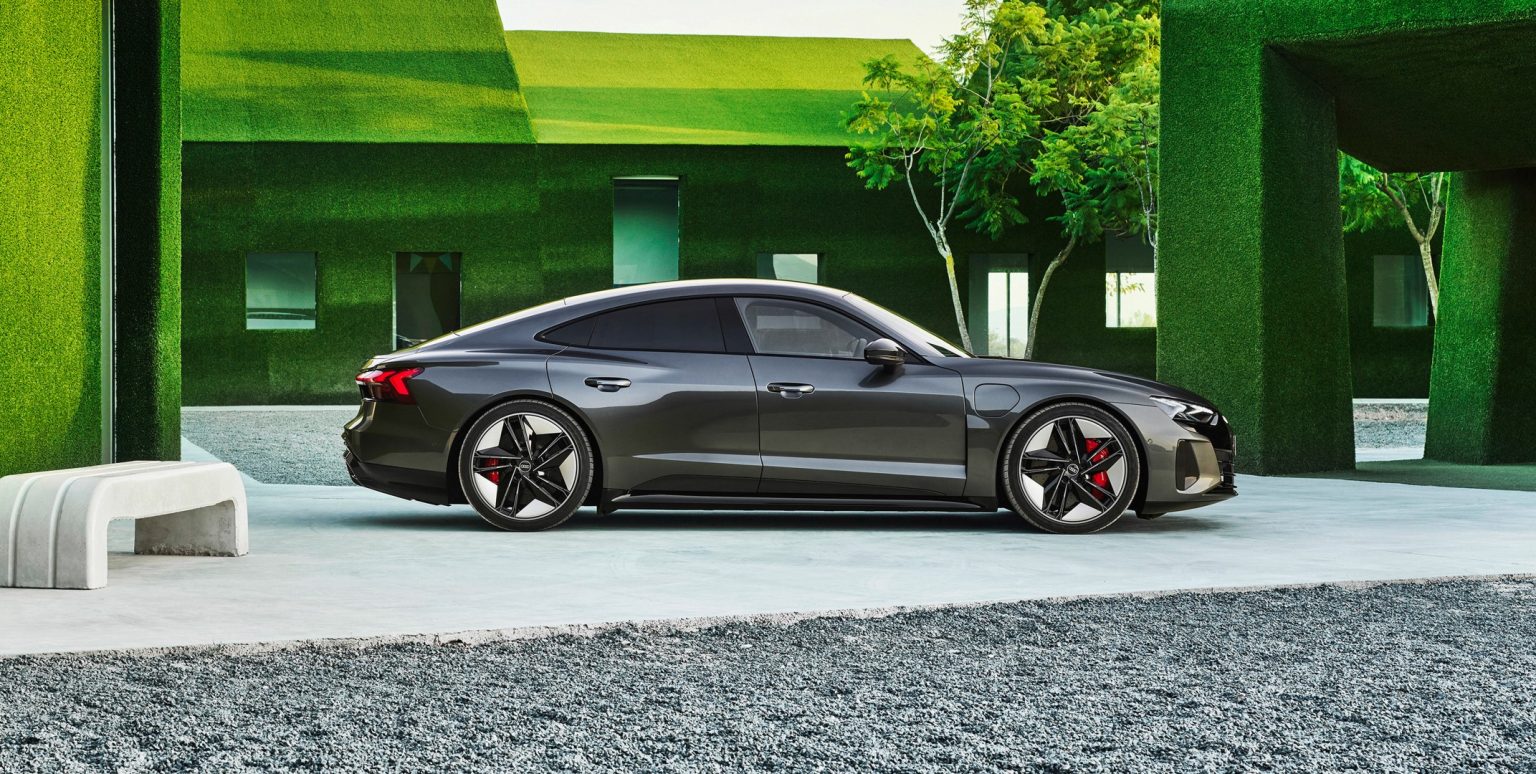
The e-tron GT models are powered by a pair of permanently excited synchronous motors. In the case of the GT, the motor on the front axle produces 175kW while the motor on the rear axle outputs 320kW. The total system output is 350kW and 390kW for around 2.5 seconds in boost mode via launch control. Maximum torque for the e-tron GT is 630Nm (640 in boost mode). The RS e-tron GT’s front axle motor produces 175kW with 335kW from the rear motor, and the total output is 440kW with 475kW available during overboost. Maximum torque is a monstrous 830Nm. Performance figures are as expected, enormously impressive. The e-tron GT takes 4.1 seconds to 100km/h, while the RS needs just 3.3 seconds and 10.9sec for 0-200km/h.
As has been the case for most Audis over the last 40 years, the e-tron GT models run quattro all-wheel drive. In this case, the system is continuously and fully variably, and can change torque distribution within a few thousandths of a second. This tech is all well and good, but how do the new e-tron GT and RS e-tron GT drive and can they excite and engage enthusiasts? ELECTRIC DREAM
ELECTRIC DREAM
It promises a seamless marriage of design and technology, but the Audi e-tron GT is so much more than another EV.
THE E-TRON GT OPENS THE BATTING for the two-model range, sitting below the RS-badged flagship. As with the proliferation of Taycan models though, we suspect that additional variants will filter into the range. For now, however, we’re sat behind the wheel of an e-tron GT and excited to find out whether the new Audi ticks the boxes to satisfy not only the early adopters who often gravitate towards EVs, but also dyed-in-the-wool car enthusiasts such as you and I.
Unlike so many companies that try to signal the EV-status of their new model by over-designing every aspect of the car, the e-tron GT looks and feels ‘normal’ both inside and outside. It’s certainly a striking-looking vehicle, but its design is harmonious – and to our eyes at least, more successful than the Porsche Taycan. The harmonious story continues inside with a well-thought-out interior that marries the expected technology with understated luxury. It’s what Audi has been doing for decades, so it shouldn’t come as a surprise, but it’s nice to see that the brand wasn’t tempted to throw out the playbook just because of the change in propulsion.
As with its RS big brother, the Audi e-tron GT quattro is based on the VW Group’s J1 platform, the very same that underpins Porsche’s highly impressive Taycan models. As with the Porsche models and the RS, the GT quattro has a 93kWh battery (gross) and uses the same motors on the front and rear axle with a two-speed gearbox on the rear.
At 350kW it generates less power than the RS, which produces 440kW, but the GT quattro still delivers that instant get up and go so loved by electric car owners and can, according to the WLTP figures, provide a range of up to 488km.
There’s a 93kWh battery slung between the axles, of which 84kWh is used to power the car’s two motors: a 175kW motor on the front axle with another on the rear producing 320kW, which transmits its power through a two-speed gearbox. The lower of the two ratios is only engaged if you select Dynamic mode or launch control.
The GT quattro reaches 100km/h in 4.5-seconds, reduced by four-tenths when launch control and the 390kW overboost function are engaged (the latter lasting for 2.5 seconds). Top speed? 245km/h.
The skateboard design of the J1 chassis is suspended by double-wishbones at the front and a multi-link set-up for the rear. Adaptive dampers and steel springs are standard on the GT quattro models, with air suspension and four-wheel steering optional in some markets (and standard on the RS). Torque vectoring is standard on the rear axle of the quattro in place of the RS’s e-diff. Note that final Australian specification and pricing will be announced closer to the launch of the e-tron GT and RS e-tron GT in early 2022.
The two paddles behind the steering wheel allow you to adjust brake regeneration, although on its maximum setting it doesn’t convert the GT into a one pedal car. Some will consider this a missed opportunity although others will like the coasting capability that you’d associate with a GT car when you lift off. Vast 20-inch wheels are standard, with a 245/45 and 285/40 tyre front and rear, respectively.
Charging is via ports positioned behind the front wheels on either side of the car, with the offside one being an AC charging port with the nearside capable of taking an AC or DC charge. There’s an 11kW onboard charger and if you can find an 800-volt charging station, it can rapid charge at 270kW or use a 400-volt 150kW rapid charge. Find the former and the battery can be charged from zero to 80 percent in 30 minutes, or you can add 100km in just 5 minutes.
As with the RS GT and its Porsche Taycan cousins, the GT quattro is a supreme GT car. Smooth, relaxed, eerily quiet and capable of covering kilometres swiftly and with an uncanny level of sophistication.
It rides with an uncharacteristic calmness, flowing across the surface rather than tap dancing along it as you might expect with such big wheels and low-profile tyres. The steering manages to hook you in and out of a turn without any dramas.
Across our route from Inverness to Gairloch that make up parts of Scotland’s challenging North Coast 500, the GT quattro flows from open corner to open corner, maintaining a pace that would require something with a very serious ICE powertrain to work very hard to pass and leave the GT behind.
During the test route it proved to be a car operating well within itself. The instant torque – 630Nm but up to 640Nm on overboost – allows for effortless overtaking and a generous shove out of corners and along the straights when required. This results in a car that brings together the very best elements of the very best GT cars in something that would also give comparable super sedans a fright.
Like all big EV sedans, the e-tron GT quattro is a lovely car to travel in and has a level of performance to keep the journey interesting. It also lays the foundation upon which the RS variant can build to engage with car enthusiasts and keen drivers.
QUIET RIOT
Sitting at the top of Audi’s electric vehicle range, the RS e-tron GT is also the brand’s first EV to wear its most sporting badge. Does it live up to the weight of expectation?
THIRTY YEARS AGO, AUDI’S Ferdinand Piëch turned to his family’s business, Porsche, to build him a car that would redefine Audi just as the Ur Quattro had in 1980. The RS2 was a project only Piëch could sanction and the result was an 80 Avant with so much Porsche knowhow thrown at it that it felt more of a fully-fledged Zuffenhausen car than the 924.
Now Audi has taken a new generation of Porsche underpinnings to create a brand-new EV in the same factory where its R8 supercar is built and where it assembled 924s and 944s for Porsche all those decades ago. Taking the J1 platform that underpins the impressive Taycan, Audi also utilises the same electric front and rear motors and their respective single- and two-speed gearboxes that Porsche has put to such good use in its Taycan Turbo and Turbo S models. The resulting Audi is the RS e-tron GT.
Don’t, however, think of the e-tron GT and RS e-tron GT as badge-engineered Porsches. As we’ve already outlined, Audi’s design and engineering teams have given the models such unique character, feel, sound and even smell, that prior knowledge of the technological tie-up is required to pick even the slightest similarities.
Despite the super sedan power and torque figures – 440kW in normal mode, 475kW on overboost, and 830Nm in either state – Audi talks about the RS e-tron very much in terms of the ‘GT’ part of its name, that is to say as a grand tourer rather than a rival for its other RS products or AMG and BMW’s big-hitting, circa-450kW sedans, coupes and wagons.
For a GT car, the RS e-tron is mighty quick. Not that this should come as a surprise because performance, specifically the off-the-line type, is every electric car’s party piece. The paperwork suggests only 3.3 seconds is required to reach 100km/h when launch control is engaged. As we know from experience both with the Taycan and with other high-performance Audi models, that seems like a conservative claim. On a damp drag strip, even with the electronic aids switched on, the rear tyres lose their fight with the surface and get a couple of over-rotations in the bag before the RS gets off the line. Once hooked up, it’s up the road and hitting indecently high figures at a rate that would embarrass a bona fide supercar. In the dry, the acceleration is truly stunning, bordering even on the uncomfortable. Our best run nets a 0-100km/h time of just 2.9 seconds, a full four tenths under the claim. And yet this is the RS e-tron GT’s least engaging feature; after the second run it’s all a bit expected.
So where does it impress? As with the Taycan, the RS e-tron GT is a very fine grand tourer, with a far broader bandwidth of ability than you’d ever expect, whether you’re an electric car sceptic or admirer. It’s the serenity behind the wheel that defines the e-tron GT. Audi fits what it calls ‘e-tron Sport Sound’ – a noise generator – to mask the sounds that are normally inaudible because there’s a twin-turbocharged V8 running at a couple of thousand rpm. So where early EVs provided a stage for wind and road noise, the GT smothers them with a soft, slightly muted bass-filled grumble. This is just one area where the Taycan and e-tron GT diverge, with Audi’s engineers giving their model a unique soundscape.
Also on the GT’s side is a ride quality that your preconceived ideas of running on 21-inch wheels wouldn’t have you believe possible. There’s a multi-link set-up for the rear of the car and double wishbones at the front, with the VW Group’s three-chamber air-suspension system fitted as standard and accompanied by active dampers. Together they provide an exceptionally compliant ride with sophisticated levels of body control and impressive reactions to poor surfaces, smothering them to near obscurity.
On a dual carriageway or motorway, the combination of near silent running and high refinement puts the GT in its element, conveying a calmness many would consider only a Rolls-Royce capable of achieving. It’s the biggest USP and most appealing attribute of this type of EV: an ability to smooth and soothe on journeys that deliver zero thrills. The obsession with how quickly these cars can accelerate misses the point, deflecting from the wider, more welcome talents of grand touring EVs.
On rather more interesting routes, this four-door coupe is no less impressive. The electromechanically assisted steering is unexpectedly good in terms of its linearity and lack of kickback, giving the RS an incredibly accurate and predictable front end. There’s a very natural feel to its weighting, and the way you can be ultra-precise with the amount of lock you need draws you in to the driving experience – which is somewhat unusual for a GT car.
The combination of strong body control, supple ride and precise steering means you soon find yourself covering ground at a rather serious pace. Use all of the available performance and the RS e-tron GT gets your senses on a high level of alert just as it would in a hard-hitting sports sedan. There’s another comparison that keeps popping into my thoughts; the breadth of ability displayed by the RS e-tron GT and the heft of its performance reminds me of a Bugatti Chiron. I’m sure that EV proponents won’t appreciate that comparison, and many of you will think that I’ve drawn the longest of long bows, but the RS and the Chiron really do cosset, engage and perform like little else.
As mentioned in our drive of the RS’s baby brother, the interior of the RS variant impresses with its familiarity and design restraint – when the base product is so well executed, one assumes that the design team didn’t feel the need to make the RS e-tron GT ‘feel’ like the future. There’s a unique design to the interior, the swathe of carbonfibre that runs through and around the cabin providing the e-tron with an identity all of its own, but the Virtual Cockpit and multimedia interface are as per the majority of today’s Audi models. Far from a criticism, this familiarity allows the e-tron GT to slot into the Audi line-up as an exciting addition rather than a model that requires explanation and justification.
The RS feels like a genuinely exciting new Audi that happens to be an EV rather than an electric vehicle poked and prodded to fit what you expect of a fast and sporting Audi. The RS e-tron GT gives us hope that the brand’s Vorsprung durch Technik slogan will continue to allow us to live by our central tenet of The Thrill of Driving.


